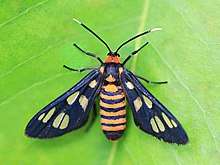Amata huebneri
Amata huebneri, the wasp moth, is a moth in the genus Amata of the family Erebidae (subfamily Arctiinae - "woolly bears" or "tiger moths"). The species was first described by Jean Baptiste Boisduval in 1829.[2] It is found from the Indo Australian tropics to northern Australia.[3]
| Amata huebneri | |
|---|---|
 | |
| Scientific classification | |
| Kingdom: | Animalia |
| Phylum: | Arthropoda |
| Class: | Insecta |
| Order: | Lepidoptera |
| Superfamily: | Noctuoidea |
| Family: | Erebidae |
| Subfamily: | Arctiinae |
| Genus: | Amata |
| Species: | A. huebneri |
| Binomial name | |
| Amata huebneri | |
| Synonyms | |
| |
Adults are black with yellow bands across the abdomen, and transparent windows in the wings. It is a wasp mimic.[4]
The larvae feed on Oryza sativa.
References
- Savela, Markku (3 April 2019). "Amata huebneri (Boisduval, 1829)". Lepidoptera and Some Other Life Forms. Retrieved 30 October 2019.
- "Amata (Genus)". ZipcodeZoo.com. Archived from the original on 7 June 2012.
- Holloway, Jeremy Daniel. "Amata huebneri Boisduval". The Moths of Borneo. Retrieved 30 October 2019.
- Herbison-Evans, Don & Crossley, Stella (9 July 2017). "Amata huebneri (Boisduval, [1828]) Wasp Moth". Australian Caterpillars and their Butterflies and Moths. Retrieved 30 October 2019. Note: This source appears to have the wrong year.
This article is issued from Wikipedia. The text is licensed under Creative Commons - Attribution - Sharealike. Additional terms may apply for the media files.